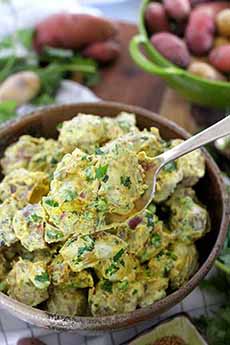RECIPE: Nepalese Potato Salad
|
|
Nepalese potato salad? What’s that? Potatoes, like chicken, provide a neutral canvas that can showcase the seasonings of any global cuisine. While most of us can’t name a Nepalese* food, we are familiar with the cuisine’s seasonings: cayenne, coriander, cumin, fenugreek and turmeric. So if you’re feeding a foodie crowd—or want to bring something different to a party—whip up a batch. Potatoes are a staple all across Nepal, served daily in every home. Buddhist monks in Nepal and Bhutan began to cultivate them in the 1700s, although it took another 150 years for them to move from the monasteries to the the general population. Chukauni is a yogurt-based potato salad from the hilly region of Palpa in midwestern Nepal. The layers of flavor include creaminess from the yogurt, assertive spices and a hint of heat from the cayenne. The recipe is from the cookbook Smashed, Mashed, Boiled and Baked, by Raghavan Iyer, a continent-by-continent celebration of the versatile potato. Ingredients |
|
|
Preparation 1. SCRUB the potatoes under cold running water and cut them into 1-inch pieces. Place them in a small or medium-size saucepan and cover them with cold water. Bring to a boil over medium-high heat. Lower the heat to medium-low, partially cover the pan, and gently boil until the potatoes are tender when pierced with a fork or knife but still firm, 10 to 12 minutes. Fish the pieces out of the water (do not discard the water) with a slotted spoon and place them in a medium-size bowl. 2. DROP the peas into the potato cooking water and boil them just to warm them up, 1 to 2 minutes. Drain them in a colander, give them a good shake or two to remove any excess water. Add the peas to the potatoes along with the onion. 3. HEAT the oil in a small skillet over medium-high heat. Once the oil appears to shimmer and smells quite pungent, sprinkle in the coriander, cumin, and fenugreek seeds. Allow them to sizzle and turn reddish brown, about 1 minute. Remove the pan from the heat and sprinkle in the cayenne and turmeric, staining the oil with their sunny dispositions. Pour most of the oil out over the potatoes and peas, holding back the seeds in the skillet as much as you can. 4. SCRAPE the seeds into a mortar and pulverize them into a coarse powder with a pestle. If you don’t have a mortar, transfer the seeds to a spice grinder and grind them. Scrape the blend into the bowl with the potatoes. 5. ADD the yogurt, cilantro and salt to the potatoes and give the mixture a good stir. Serve at room temperature. Potatoes originated in Peru, where they were a dietary staple. They were brought to Europe in the 16th century by Spanish Explorers. In Europe, early potato salads were made by boiling potatoes in wine or a mixture of vinegar and spices. The first American potato salads were likely versions of the German potato salad, brought to the U.S. by German emigrants in the mid-19th century. In those recipes, cooked potatoes were dressed with oil, vinegar and herbs, often blended with coarse mustard and some sugar. Hot potato salad, made with bacon, onion and an oil and vinegar dressing, became known as German potato salad. Here’s the recipe. We don’t know the person who created what became the iconic American potato salad with mayonnaise. Commercial mayonnaise was available in the early 1900s, but it wasn’t until the 1920s and 1930s, with the introduction of brands such as Hellman’s and and Miracle Whip, that mayonnaise-based potato salads achieved popularity [source]. Chopped celery and dried herbs were added to the mix. Our mom added diced red onion and mixed the mayo with a bit of Dijon mustard. Many cooks added their own twists along with the mayo, creating a sea of comfort food recipes. ________________ *Nepal is a landlocked country in South Asia. It is located mainly in the Himalayas, and is the home of Mount Everest. The capital is Kathmandu. Nepal is popular for mountaineering, with some of the highest and most challenging mountains in the world. While many people think of Mount Everest as being in Tibet, it spans Nepal and China as well. The southeast ridge on the Nepali side of the mountain is easier to climb, so most climbers prefer to trek to Everest through Nepal. Here’s an overview of Nepalese cuisine.
|
||




